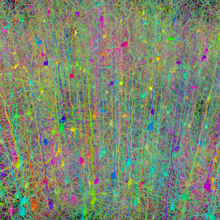
Neural binding is the neuroscientific aspect of what is commonly known as the binding problem: the interdisciplinary difficulty of creating a comprehensive and verifiable model for the unity of consciousness. "Binding" refers to the integration of highly diverse neural information in the forming of one's cohesive experience. The neural binding hypothesis states that neural signals are paired through synchronized oscillations of neuronal activity that combine and recombine to allow for a wide variety of responses to context-dependent stimuli. These dynamic neural networks are thought to account for the flexibility and nuanced response of the brain to various situations.[1] The coupling of these networks is transient, on the order of milliseconds, and allows for rapid activity.[2]
A viable mechanism for this phenomenon must address (1) the difficulties of reconciling the global nature of the participating (exogenous) signals and their relevant (endogenous) associations, (2) the interface between lower perceptual processes and higher cognitive processes, (3) the identification of signals (sometimes referred to as “tagging”) as they are processed and routed throughout the brain, and (4) the emergence of a unity of consciousness.
Proposed adaptive functions of neural binding have included the avoidance of hallucinatory phenomena generated by endogenous patterns alone as well as the avoidance of behavior driven by involuntary action alone.[3]
There are several difficulties that must be addressed in this model. First, it must provide a mechanism for the integration of signals across different brain regions (both cortical and subcortical). It must also be able to explain the simultaneous processing of unrelated signals that are held separate from one another and integrated signals that must be viewed as a whole.[1]
- ^ a b Senkowski, D.; T.R. Schneider; J.J. Foxe; A.K. Engel (2008). "Crossmodal binding through neural coherence: implications for multisensory processing". Trends in Neurosciences. 31 (8): 401–409. doi:10.1016/j.tins.2008.05.002. PMID 18602171. S2CID 14535021.
- ^ Rippon i, G.; J. Brock; C. Brown; J. Boucher (2007). "Disordered connectivity in the autistic brain: Challenges for the 'new psychophysiology'". International Journal of Psychophysiology. 63 (2): 164–172. doi:10.1016/j.ijpsycho.2006.03.012. PMID 16820239.
- ^ da Rocha, A.F.; A. Pereira Jr.; F.A.B. Coutinho (October 2001). "N-methyl-D-aspartate channel and consciousness: from signal coincidence detection to quantum computing". Progress in Neurobiology. 64 (1): 555–573. doi:10.1016/S0301-0082(00)00069-1. PMID 11311462. S2CID 9129440.
